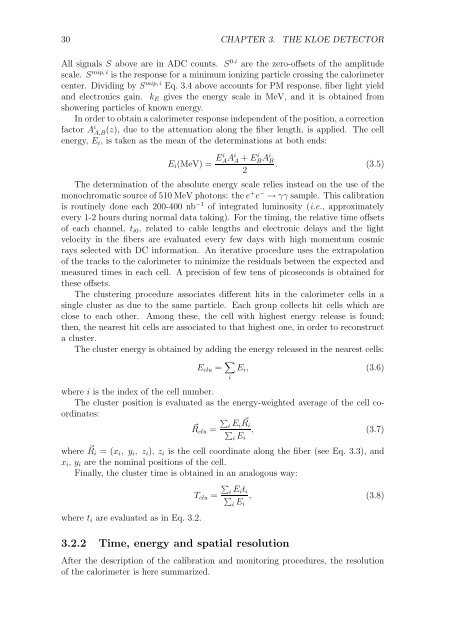Universit`a degli studi Roma Tre Measurement of the KL meson ...
Universit`a degli studi Roma Tre Measurement of the KL meson ...
Universit`a degli studi Roma Tre Measurement of the KL meson ...
You also want an ePaper? Increase the reach of your titles
YUMPU automatically turns print PDFs into web optimized ePapers that Google loves.
30 CHAPTER 3. THE <strong>KL</strong>OE DETECTOR<br />
All signals S above are in ADC counts. S 0,i are <strong>the</strong> zero-<strong>of</strong>fsets <strong>of</strong> <strong>the</strong> amplitude<br />
scale. S mip, i is <strong>the</strong> response for a minimum ionizing particle crossing <strong>the</strong> calorimeter<br />
center. Dividing by S mip, i Eq. 3.4 above accounts for PM response, fiber light yield<br />
and electronics gain. kE gives <strong>the</strong> energy scale in MeV, and it is obtained from<br />
showering particles <strong>of</strong> known energy.<br />
In order to obtain a calorimeter response independent <strong>of</strong> <strong>the</strong> position, a correction<br />
factor Ai A,B (z), due to <strong>the</strong> attenuation along <strong>the</strong> fiber length, is applied. The cell<br />
energy, Ei, is taken as <strong>the</strong> mean <strong>of</strong> <strong>the</strong> determinations at both ends:<br />
Ei(MeV) = Ei AAi A + Ei BAi B<br />
. (3.5)<br />
2<br />
The determination <strong>of</strong> <strong>the</strong> absolute energy scale relies instead on <strong>the</strong> use <strong>of</strong> <strong>the</strong><br />
monochromatic source <strong>of</strong> 510 MeV photons: <strong>the</strong> e + e− → γγ sample. This calibration<br />
is routinely done each 200-400 nb−1 <strong>of</strong> integrated luminosity (i.e., approximately<br />
every 1-2 hours during normal data taking). For <strong>the</strong> timing, <strong>the</strong> relative time <strong>of</strong>fsets<br />
<strong>of</strong> each channel, ti0, related to cable lengths and electronic delays and <strong>the</strong> light<br />
velocity in <strong>the</strong> fibers are evaluated every few days with high momentum cosmic<br />
rays selected with DC information. An iterative procedure uses <strong>the</strong> extrapolation<br />
<strong>of</strong> <strong>the</strong> tracks to <strong>the</strong> calorimeter to minimize <strong>the</strong> residuals between <strong>the</strong> expected and<br />
measured times in each cell. A precision <strong>of</strong> few tens <strong>of</strong> picoseconds is obtained for<br />
<strong>the</strong>se <strong>of</strong>fsets.<br />
The clustering procedure associates different hits in <strong>the</strong> calorimeter cells in a<br />
single cluster as due to <strong>the</strong> same particle. Each group collects hit cells which are<br />
close to each o<strong>the</strong>r. Among <strong>the</strong>se, <strong>the</strong> cell with highest energy release is found;<br />
<strong>the</strong>n, <strong>the</strong> nearest hit cells are associated to that highest one, in order to reconstruct<br />
a cluster.<br />
The cluster energy is obtained by adding <strong>the</strong> energy released in <strong>the</strong> nearest cells:<br />
Eclu = <br />
i<br />
Ei, (3.6)<br />
where i is <strong>the</strong> index <strong>of</strong> <strong>the</strong> cell number.<br />
The cluster position is evaluated as <strong>the</strong> energy-weighted average <strong>of</strong> <strong>the</strong> cell coordinates:<br />
Rclu =<br />
<br />
i Ei Ri<br />
<br />
i Ei<br />
, (3.7)<br />
where Ri = (xi, yi, zi), zi is <strong>the</strong> cell coordinate along <strong>the</strong> fiber (see Eq. 3.3), and<br />
xi, yi are <strong>the</strong> nominal positions <strong>of</strong> <strong>the</strong> cell.<br />
Finally, <strong>the</strong> cluster time is obtained in an analogous way:<br />
<br />
i Eiti<br />
Tclu = , (3.8)<br />
i Ei<br />
where ti are evaluated as in Eq. 3.2.<br />
3.2.2 Time, energy and spatial resolution<br />
After <strong>the</strong> description <strong>of</strong> <strong>the</strong> calibration and monitoring procedures, <strong>the</strong> resolution<br />
<strong>of</strong> <strong>the</strong> calorimeter is here summarized.
















